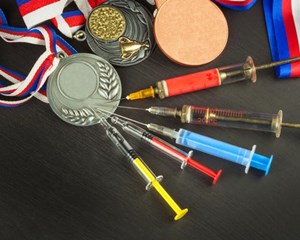The pipeline of new drugs is unlikely to run dry, says Dr Cooper, for the human body contains hundreds of processes and chemical targets that might be tweaked to boost sporting performance. There is often more than one biochemical way to achieve the desired effect. Rather than beefing up an athlete's muscles, another new class of drugs, myostatin inhibitors, slow the routine breakdown of muscle tissue, offering an alternative way of increasing strength. Cyclists, meanwhile, are rumoured to have been experimenting with a drug called AICAR, hoping it will help them lose weight while holding on to muscle mass. As with EPO, says Dr Tucker, the idea is to improve the all-important power-to-weight ratio— but by tinkering with the "weight" side of the equation instead of the "power" side.
庫珀博士說,新藥的生產(chǎn)線不太可能枯竭,因為人體內(nèi)有數(shù)百個工序和化學指標,這些工序和指標可以通過調(diào)整來提高運動成績。達到預期效果的生化方法往往不止一種。另一類新藥,“肌抑素抑制劑”,它無法增強運動員的肌肉,而是通過減緩肌肉組織的常規(guī)分解來增強力量。與此同時,有傳言稱自行車手一直在試驗一種名為AICAR的藥物,希望能夠在維持肌肉質(zhì)量的前提下降低體重。塔克博士表示,與促紅細胞生成素一樣,這種方法的目的是提高能量體重比,這至關(guān)重要——不過是在等式的“重量”一側(cè)而不是“能量”一側(cè)進行修補。

Those who prefer to stick with the old favourites can simply try using less. "Micro-dosing"—taking regular small doses instead of occasional big ones—ensures a drug will clear the body faster, making an athlete less likely to fail a test. New ways of administering old drugs help too. In a book published last year Grigory Rodchenkov, a chemist who ran the laboratory in Moscow that was at the centre of the Russian doping scandal, recounts how he developed "Duchess", a whisky-based cocktail that included the steroids trenbolone, oxyandrolone and methenolone. The idea was that absorption directly through the tissues of the mouth would produce fewer telltale metabolites than injections or pills, and thus cut the risk of detection.
那些無法割舍舊愛的人可以嘗試用一點點。“微劑量”——定期小劑量服用,而不是偶爾大劑量服用——可以確保藥物更快地清除體內(nèi)的毒素,降低運動員在測試中失敗的可能性。新的使用老藥的方法也有幫助。在去年出版的一本書中,格里戈里·羅琴科夫講述了他是如何開發(fā)出“公爵夫人”雞尾酒的,這是一種以威士忌為基礎的雞尾酒,含有steroids trenbolone、oxyandrolone和metholone。他們的想法是,直接通過口腔組織吸收會比注射或藥片產(chǎn)生更少的代謝物,從而降低被檢測到的風險。
Lower-tech strategies can work, too. One is to get a therapeutic use exemption (TUE)—a doctor's note saying you need a drug for medical reasons. WADA insists that TUES are granted only after rigorous checks. A paper from 2020 found no evidence that athletes with TUEs were more likely to win than others. But doubts persist. In 2018 Britain's Parliament accused Team Sky, a cycling team, of using TUEs to help supply PEDS to riders. (They deny it.)
技術(shù)含量較低的策略也能奏效。一種是獲得治療用途豁免(TUE)——醫(yī)生開具的證明,說明你出于醫(yī)療原因需要某種藥物。世界反興奮劑機構(gòu)堅持說,TUEs僅在嚴格檢查后才會授予。2020年的一篇論文發(fā)現(xiàn),沒有證據(jù)表明帶TUEs的運動員會比其他運動員更有可能獲勝。不過疑慮依然存在。2018年,英國議會指責自行車隊“天空隊”利用TUEs向騎手提供興奮劑。(他們否認。)
譯文由可可原創(chuàng),僅供學習交流使用,未經(jīng)許可請勿轉(zhuǎn)載。











